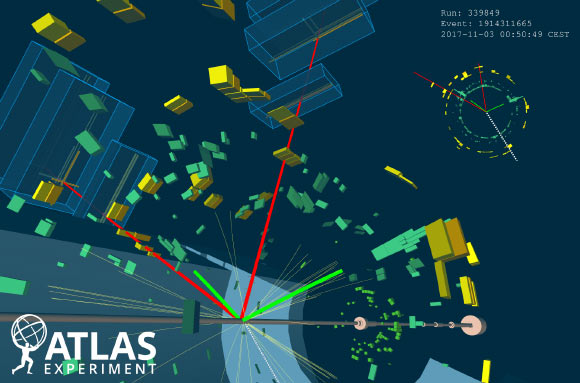Physicists from the ATLAS Collaboration at CERN’s Large Hadron Collider (LHC) have performed new measurements of Higgs boson’s decay width, which is linked to the particle’s lifetime. Their results are compatible with those from a recent study by physicists from CERN’s CMS Collaboration.

ATLAS candidate event for a Higgs boson decaying into two Z bosons that in turn decay into two muons and two electrons. Image credit: CERN.
Width is a fundamental parameter of any unstable particle with a finite lifetime — the shorter the lifetime, the broader the width.
The Higgs boson’s width, which represents the range of possible masses around the particle’s nominal mass of 125 GeV, is predicted to be 4.1 MeV — too small to be directly measured.
However, its value can be determined by comparing the rate of Higgs boson production at the particle’s nominal mass (on-shell production) with that at much larger masses (off-shell production).
This relies on the fact that the on-shell Higgs boson production rate depends not only on the Higgs boson’s interactions with other particles, but also on its width. By contrast, the off-shell rate is, to a good approximation, independent of the width.
In the new study, physicists with the ATLAS Collaboration looked for off-shell Higgs boson production using proton-proton collision data collected during Run 2 of the LHC from 2015 to 2018.
In particular, they searched for collision events where the Higgs boson transforms, or decays, into two Z bosons, which in turn decay into four charged leptons or two charged leptons plus two neutrinos, as these decay channels provided the highest sensitivity to the off-shell signal.
After isolating these events from those of background processes that resemble them but do not involve the Higgs boson, they combined the results from both channels to measure the ratio of the off-shell Higgs boson production rate to its Standard-Model prediction.
The data were found to be consistent with Standard Model predictions, rejecting the background-only hypothesis, which assumes no off-shell Higgs boson production, with an observed (expected) statistical significance of 3.2 (2.4) standard deviations.
These new results provide experimental evidence of off-shell Higgs boson production.
By combining the results with their previous on-shell Higgs boson measurements, the researchers obtained a Higgs boson width of 4.6 MeV, with upper and lower uncertainties of 2.6 and -2.5 MeV, respectively.
This value is in agreement with the Standard Model expectation and corresponds to a particle lifetime of 1.8*10-22 seconds.
The results are compatible with those from a recent study by the CMS collaboration, which also found evidence of off-shell Higgs boson production and measured the particle’s width.
_____
The ATLAS Collaboration. 2022. Evidence of off-shell Higgs boson production and constraints on the total width of the Higgs boson in the the ZZ->4ℓ and ZZ->2ℓ2ν decay channels with the ATLAS detector. ATLAS-CONF-2022-068







